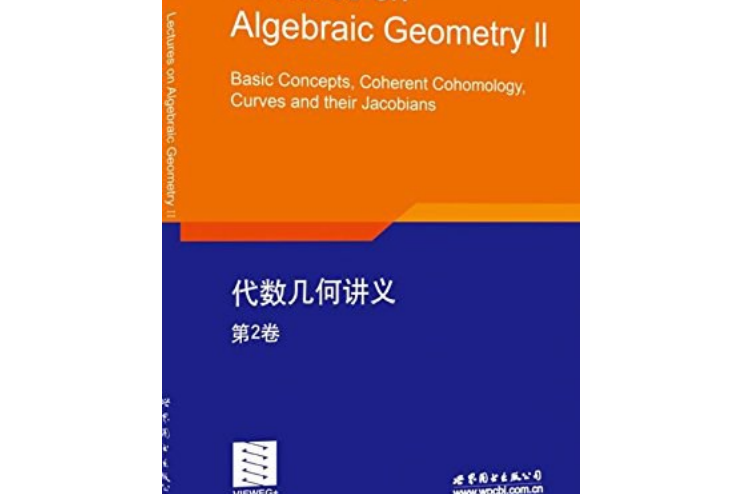內容簡介
本書分為2卷,全面介紹了現代代數幾何的概念與理論。全書分為10章,第1卷包括第1章至第5章。第2卷包括第6章至第10章。第2卷作者首先引入概型理論的基本概念,隨後介紹交換代數和概型等內容。第2卷目次:概型理論的基本概念;交換代數;射影概型;曲線和Riemann-Roch定理;曲線和雅克比行列式用的皮卡函子。
圖書目錄
Preface
Contents
Introduction
6 Basic Concepts of the Theory of Schemes
6.1 Affine Schemes
6.1.1 Localization
6.1.2 The Spectrum of aRing
6.1.3 The Zaski Topology on Spec(A1)
6.1.4 The Structure Sheaf on Spec(A1 )
6.1.5 Quasicoherent Sheaves
6.1.6 Schemes as Locally Ringed Spaces
Closed Subschemes
Sections
A remark
6.2 Schemes
6.2.1 TheDefinition of a Scheme
The gluing
Closed subschemes again
Annihilators,supports and intersections
6.2.2 Functorial properties
Affinemorphisms
Sections again
6.2.3 Construction of Quasi—coherent Sheaves
Vector bundles
Vector Bundles Attached to Locally Free Modules
6.2.4 Vector bundles and GLn—torsors
6.2.5 Schemes over a base scheme S
Some notions of finiteness
Fibered products
Base change
6.2.6 Points,T—valued Points and Geometric Points
Closed Points and Geometric Points on varieties
6.2.7 Flat Morphisms
The Concept of Flatness
Representability of functors
6.2.8 Theory of descend
Effectiveness for affine descend data
6.2.9 Galois descend
A geometric interpretation
Descend for general schemes of finite type
6.2.10 Forms of schemes
6.2.11 An outlook to more general concepts
7 Some Commutative Algebra
7.1 Finite A—Algebras
7.1.1 Rings With Finiteness Conditions
7.1.2 Dimension theory for finitely generated k—algebras
7.2 Minimal prime ideals and deposition into irreducibles
Associated prime ideals
The restriction to the ponents
Deposition into irreducibles for noetherian schemes
Local dimension
7.2.1 Affine schemes over k and change of scalars
What is dim(Zi n Z2)?
7.2.2 Local Irreducibility
The connected ponent of the identity of an affine group scheme G/K
7.3 Low Dimensional Rings
Finite k—Algebras
One Dimensional Rings and Basic Results from Algebraic Number
Theory
7.4 Flat morphisms
7.4.1 Finiteness Properties of Tor
7.4.2 Construction of flat families
7.4.3 Dominant morphisms
Birational morphisms
The Artin—Rees Theorem
7.4.4 Formal Schemes and Infinitesimal Schemes
7.5 Smooth Points
The Jacobi Criterion
7.5.1 Generic Smoothness
The singular locus
7,5.2 Relative Differentials
7.5.3 Examples
7.5.4 Normal schemes and smoothness in codimension one
Regular local rings
7.5.5 Vector fields, derivations and infinitesimal automorphisms
Automorphisms
7.5.6 Group schemes
7.5.7 The groups schemes Ga,Gm and μn
7.5.8 Actions of group schemes
Projective Schemes
8.1 Geometric Constructions
8.1.1 The Projective Space Pna
Homogenous coordinates
8.1.2 Closed subschemes
8.1.3 Projective Morphisms and Projective Schemes
Locally Free Sheaves on Pn
Opn(d) as Sheaf of Meromorphic Functions
The Relative Differentials and the Tangent Bundle of Pns
8.1.4 Seperated and Proper Morphisms
8.1.5 The Valuative Criteria
The Valuative Criterion for the Projective Space
8.1.6 The Construction Proj(R)
A special case of a finiteness result
8.1.7 Ample and Very Ample Sheaves
8.2 Cohomology of Quasicoherent Sheaves
8.2.1 Cech cohomology
8.2.2 The Kunh—formulae
8.2.3 The cohomology of the sheaves OPn(r)
8.3 Cohomology of Coherent Sheaves
The Hilbert polynomial
8.3.1 The coherence theorem for proper morphisms
Digression: Blowing up and contracting
8.4 Base Change
8.4.1 Flat families and intersection numbers
The Theorem of Bertini
8.4.2 The hyperplane section and intersection numbers of line bundles
Curves and the Theorem of Riemann—Roch
9.1 Some basic notions
9.2 The local rings at closed points
9.2.1 The structure of OCp
9.2.2 Base change
9.3 Curves and their function fields
9.3.1 Ramification and the different ideal
9.4 Line bundles and Divisors
9.4.1 Divisors on curves
9.4.2 Properties of the degree
Line bundles on non smooth curves have a degree
Base change for divisors and line bundles
9.4.3 Vector bundles over a curve
Vector bundles on P
9.5 The Theorem of Riemann—Roch
9.5.1 Differentials and Residues
9.5.2 The special case C = P1/k
9.5.3 Back to the general case
9.5.4 Riemann—Roch for vector bundles and for coherent sheaves
The structure of K'(C)
9.6 Applications of the Riemann—Roch Theorem
9.6.1 Curves oflow genus
9.6.2 The moduli space
9.6.3 Curves of higher genus
The "moduli space" of curves of genus g
9.7 The Grothendieck—Riemann—Roch Theorem
9.7.1 A special case of the Grothendieck —Riemann—Roch theorem
9.7.2 Some geometric considerations
9.7.3 The Chow ring
Base extension of the Chow ring
9.7.4 The formulation of the Grothendieck—Riemann_Roch Theorem
9.7.5 Some special cases of the Grothendieck—Riemann—Roch—Theorem
9.7.6 Back to the case P2 : X =C xC →C
9.7.7 Curves over firute fields
Elementary properties of the <—function
The Riemann hypothesis
10 The Picard functor for curves and their Jacobians
Introduction:
10.1 The construction of the Jacobian
10.1.1 Generalities and heuristics
Rigidification of PIC
10.1.2 General properties of the functor PIC
10.1.3 Infinitesimalproperties
Differentiating a line bundle along a vector field
The theorem of the cube
10,1.4 The basic principles of the construction of the Picard scheme of a
10.1.5 Symmetric powers
10.1.6 The actual construction of the Picard scheme of a curve
10.1.7 The local representability of PTC
10.2 The Picard functor on X and on J
Some heurist/e remarks
10.2.1 Construction of line bundles on X and on J
The homomorphismsφM
10.2.2 The projectivity of X and J
The morphismsφ are homomorphisms of functors
10.2.3 Maps from the curve C to X , local representability of PICX/k , PICj/k
and the self duality of the Jacobian
10.2.4 The self duality of the Jacobian
10.2.5 General abelian varieties
10.3 The ring of endomorphisms End(J) and the t—adic modules Te(J)
Some heuristics and outlooks
The study of End(J)
The degree and the trace
The Weil Pairing
The Neron—Severi groups NS(J),NS(J x J) and End(J)
The ring of correspondences
10.4 Etale Cohomology
The cyclotomic character
10.4.1 Etale cohomology groups
Galois cohomology
The geometric etale cohomology groups
10.4.2 Schemes over finite fields
The global case
The degenerating family of elliptic curves
Bibliography
Index

